Marcia Thornton Jones's Blog, page 111
September 25, 2018
THIS POST HAS NO PICTURES (HOLLY SCHINDLER)
Believe me, you don't want 'em.
Because wherever I'm doing my writing, trust me--it's a mess.
It's not just my office, either--which is a perpetual disaster zone. Wherever I'm working, if I've been there more than ten minutes, it is covered with:
* manuscript printouts--especially if I'm engaged in a rewrite* a cup of coffee*another cup of coffee, which I got when I couldn't find the first cup of coffee, which I later found under my chair*a bowl for breakfast oatmeal*a plate for my lunch sandwich*a few random utensils (spoon, butter knife with mustard on it, etc.)*a bottle of Vitamin Water and / or a Sonic cup*dog hair*more dog hair*my phone*my calendar*the long-sleeved shirt I had on earlier over my T-shirt, but took off because it started to get hot*a crumpled-up pair of socks, for the same reason*my current knitting project, to work on during "think" spells*a bill I'm contesting (why is it I'm ALWAYS having to contest a bill???)*if I'm outside, a can of bug spray*if I'm on the deck, my mosquito plant*damp towels (because I guarantee I knocked the Sonic cup or my coffee over a couple of times)*the mail*still more dog hair*spiral notebooks filled with to-do notes*spiral notebooks for book ideas I get int he midst of the current WIP*pens*more pens*pens I got when I couldn't find any of the other pens, which some how migrated under the spiral notebooks*my camera*a couple of thesauruses (thesauri?), because I like them better than online synonym-finders*my dog*my dog's leash*the socks I put on because it was starting to get cold again*the long-sleeved shirt I put back on, for the same reason
It finally dawned on me that my workspaces are always cluttered because my mind is always cluttered. (Big surprise, eh?) I'm always thinking about ten things at once. But the thing is, the more I try to fight it, the tougher time I have. I'm better off letting my head ping around, writing twenty minutes and then bouncing to emails and then coming back to writing and then handing a phone call, etc. It sounds like working in a constant disaster zone. I'm sure that's how it looks. But it works. It's what's comfortable for me.
That's the thing. Your workspace (and by extension, your work schedule) should be what's comfortable for you. Maybe that includes wearing your favorite knit hat. Or writing to show-tunes. Or writing every other day. Or writing in the early morning hours. Sometimes, I like to draft in front of the TV. The past several months (ahem, two years), I've also written while keeping several news feeds open on my computer. Maybe you need silence (I do when I'm revising or copyediting). Just be honest about what works. And remember: one writer's disaster zone is another's ah, this is just right.
Because wherever I'm doing my writing, trust me--it's a mess.
It's not just my office, either--which is a perpetual disaster zone. Wherever I'm working, if I've been there more than ten minutes, it is covered with:
* manuscript printouts--especially if I'm engaged in a rewrite* a cup of coffee*another cup of coffee, which I got when I couldn't find the first cup of coffee, which I later found under my chair*a bowl for breakfast oatmeal*a plate for my lunch sandwich*a few random utensils (spoon, butter knife with mustard on it, etc.)*a bottle of Vitamin Water and / or a Sonic cup*dog hair*more dog hair*my phone*my calendar*the long-sleeved shirt I had on earlier over my T-shirt, but took off because it started to get hot*a crumpled-up pair of socks, for the same reason*my current knitting project, to work on during "think" spells*a bill I'm contesting (why is it I'm ALWAYS having to contest a bill???)*if I'm outside, a can of bug spray*if I'm on the deck, my mosquito plant*damp towels (because I guarantee I knocked the Sonic cup or my coffee over a couple of times)*the mail*still more dog hair*spiral notebooks filled with to-do notes*spiral notebooks for book ideas I get int he midst of the current WIP*pens*more pens*pens I got when I couldn't find any of the other pens, which some how migrated under the spiral notebooks*my camera*a couple of thesauruses (thesauri?), because I like them better than online synonym-finders*my dog*my dog's leash*the socks I put on because it was starting to get cold again*the long-sleeved shirt I put back on, for the same reason
It finally dawned on me that my workspaces are always cluttered because my mind is always cluttered. (Big surprise, eh?) I'm always thinking about ten things at once. But the thing is, the more I try to fight it, the tougher time I have. I'm better off letting my head ping around, writing twenty minutes and then bouncing to emails and then coming back to writing and then handing a phone call, etc. It sounds like working in a constant disaster zone. I'm sure that's how it looks. But it works. It's what's comfortable for me.
That's the thing. Your workspace (and by extension, your work schedule) should be what's comfortable for you. Maybe that includes wearing your favorite knit hat. Or writing to show-tunes. Or writing every other day. Or writing in the early morning hours. Sometimes, I like to draft in front of the TV. The past several months (ahem, two years), I've also written while keeping several news feeds open on my computer. Maybe you need silence (I do when I'm revising or copyediting). Just be honest about what works. And remember: one writer's disaster zone is another's ah, this is just right.
Published on September 25, 2018 18:12
September 22, 2018
The Ultimate Imaginary Friend: Smack Dab in the Imagination by Dia Calhoun
“She has a wonderful imagination.” That’s one of the most common adjectives used to describe a powerful imagination. But that’s vague. There are many kind of imaginations. By defining the kind of imagination you want, you can cultivate and develop it.
Start by making your imagination a friend—the ultimate imaginary friend. Do you want her to be creative? Wacky? Wild? Is she red-haired and outgoing? Dark-eyed and dreamy? Will she make you laugh or sing?
What kind of adventures do you want to have with her? Would she take you to street fairs and open mike nights? Or cathedrals of forests? To strange islands over seas swimming with fantastic fish or cities you’ve never heard of before?
Grab you bus pass, your library card, and your flying shoes, and go! See what your imagination wants to become.
Published on September 22, 2018 22:00
September 20, 2018
An Author Field Trip, For Real
As a former teacher, I planned plenty of field trips - a nature walk in the arboretum, a visit to the zoo, or an afternoon spent at a health museum learning about the digestive system. But on those trips, though they were fun, my role as the teacher was to be the one responsible. For everyone. Students, room parents, and bus drivers. Yes, learning something was paramount; but, to be realistic, returning to school with the same number of students I had left with was absolutely the ONLY way the day would be a success. :) That's a big responsibility, even on a good day when everything goes as planned, and as we know, life doesn't always go as planned.
That's why, when I become an author and planned field trips that were just for me, field trips took on a whole new meaning. Responsible only for myself (and my husband if he happened to like whatever adventure I was going on), I got to head out into the world in search of first-hand knowledge and experiences that would help me be more inspired and authentic in my writing.
The trips I took to the Okefenokee Swamp for my most recent book, Elsie Mae Has Something to Say, are perfect examples of how amazing author field trips can be. And though I wouldn't really want to be responsible for you, especially in a place like the Okefenokee Swamp, I wish everyone could visit this hidden-gem-of-a-place. To give you a little taste of how amazing my trips to the swamp were, here are some photos:
 The Okefenokee Swamp is in the southeastern part of the state of Georgia. There are three places where visitors can enter the swamp and experience its wonders.
The Okefenokee Swamp is in the southeastern part of the state of Georgia. There are three places where visitors can enter the swamp and experience its wonders.
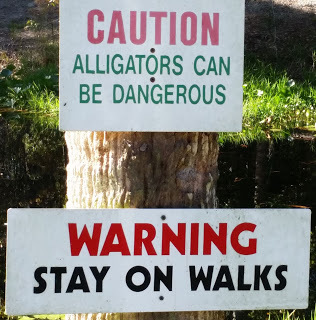 The Okefenokee has plenty of adventure.
The Okefenokee has plenty of adventure.
 And it's for real!
And it's for real!

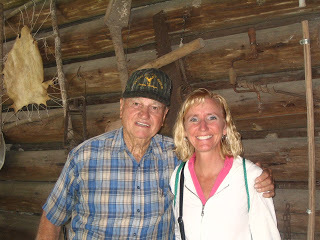 Before the Okefenokee became a national wildlife refuge, settlers, called swampers, lived there. Some of the park volunteers grew up in and around the swamp. They happily shared tidbits and stories of the lives they lived as swampers.
Before the Okefenokee became a national wildlife refuge, settlers, called swampers, lived there. Some of the park volunteers grew up in and around the swamp. They happily shared tidbits and stories of the lives they lived as swampers.

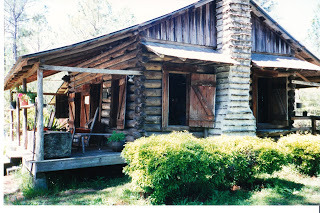 Several swamper homesteads have been preserved so that visitors can see what swamper life was really like.
Several swamper homesteads have been preserved so that visitors can see what swamper life was really like.
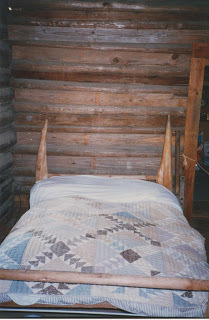
 To me, the Okefenokee is a wonderful and mysterious place with a rich and unique history - the perfect setting for a story. My author field trips provided inspiration and firsthand experience about the Okefenokee and the swampers who lived there so that I could tell an authentic story.
To me, the Okefenokee is a wonderful and mysterious place with a rich and unique history - the perfect setting for a story. My author field trips provided inspiration and firsthand experience about the Okefenokee and the swampers who lived there so that I could tell an authentic story.
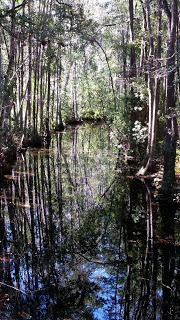

Elsie Mae Has Something to Say is the story of how one girl, on the way to becoming a hero, finds out that even when you succeed in saving something for the good of all, there still might be a price everyone has to pay; and sometimes in the end, it might be hard to know if it was all worth it.
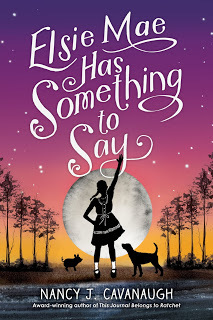
So if there's something you'd like to write about, or maybe just something you want to experience or know more about, plan a field trip of your own because field trips aren't just for kids.
Travel on,Nancy
That's why, when I become an author and planned field trips that were just for me, field trips took on a whole new meaning. Responsible only for myself (and my husband if he happened to like whatever adventure I was going on), I got to head out into the world in search of first-hand knowledge and experiences that would help me be more inspired and authentic in my writing.
The trips I took to the Okefenokee Swamp for my most recent book, Elsie Mae Has Something to Say, are perfect examples of how amazing author field trips can be. And though I wouldn't really want to be responsible for you, especially in a place like the Okefenokee Swamp, I wish everyone could visit this hidden-gem-of-a-place. To give you a little taste of how amazing my trips to the swamp were, here are some photos:
 The Okefenokee Swamp is in the southeastern part of the state of Georgia. There are three places where visitors can enter the swamp and experience its wonders.
The Okefenokee Swamp is in the southeastern part of the state of Georgia. There are three places where visitors can enter the swamp and experience its wonders. The Okefenokee has plenty of adventure.
The Okefenokee has plenty of adventure.
 And it's for real!
And it's for real!

 Before the Okefenokee became a national wildlife refuge, settlers, called swampers, lived there. Some of the park volunteers grew up in and around the swamp. They happily shared tidbits and stories of the lives they lived as swampers.
Before the Okefenokee became a national wildlife refuge, settlers, called swampers, lived there. Some of the park volunteers grew up in and around the swamp. They happily shared tidbits and stories of the lives they lived as swampers.

 Several swamper homesteads have been preserved so that visitors can see what swamper life was really like.
Several swamper homesteads have been preserved so that visitors can see what swamper life was really like.

 To me, the Okefenokee is a wonderful and mysterious place with a rich and unique history - the perfect setting for a story. My author field trips provided inspiration and firsthand experience about the Okefenokee and the swampers who lived there so that I could tell an authentic story.
To me, the Okefenokee is a wonderful and mysterious place with a rich and unique history - the perfect setting for a story. My author field trips provided inspiration and firsthand experience about the Okefenokee and the swampers who lived there so that I could tell an authentic story.


Elsie Mae Has Something to Say is the story of how one girl, on the way to becoming a hero, finds out that even when you succeed in saving something for the good of all, there still might be a price everyone has to pay; and sometimes in the end, it might be hard to know if it was all worth it.


So if there's something you'd like to write about, or maybe just something you want to experience or know more about, plan a field trip of your own because field trips aren't just for kids.
Travel on,Nancy
Published on September 20, 2018 04:30
September 19, 2018
Where I Write
“You’re in my spot.”
If anyone has tuned into the comedy, The Big Bang Theory, you’ve seen Sheldon and his obsession with his favorite spot.
I also have favorite spots. Especially when I write.
It has, actually, become a slight problem in the past. I once took to writing a novel on my sun porch. It was spring, and the afternoons were sunny and pleasantly warm. Perfectly fine in May, but by July when I was steadfast that I had to keep writing that novel on the sun porch, it was a scorching 98 degrees with zero breeze. Not to mention, I did not have a comfortable office chair, but instead a metal folding chair. You can imagine my comfort level as I pounded away on my laptop in determination.
There are other times I make a more solid choice of writing in a quiet office where I can control the temperature. If, however, I make the decision to have a cup of mint tea on a good writing day, you can bet I’ll be fixing mint tea for the duration of that manuscript.
Sidebar: I’m sick of mint tea.
Perhaps most steadfast in location is my cat, Boots. Boots has inspired my middle grade novels, about a curious cat-turned-detective. No matter where I am in the house, Boots has a cat tree. Or, as I like to call it when I’m working, his Perch of Judgement. He watches me diligently typing away, his elegant and bright green eyes drilling into me if I get stuck on a plot point or bit of dialogue.
He rarely offers advice.
I tend to be slightly high-strung and a person who sticks to routine. Maybe it’s stability, or maybe it’s even slightly superstitious when I’m writing that I apply those same principles.
At rare times, I’ll take myself out of the house to write at a coffeeshop. This can be dangerous as many of those delicious lattes are not only high in caffeine and price but also caloric value. No writer wants to vibrate the rest of the day, especially if they are already penning an intense plot.
I have learned little from where I write and what it means to my writing process outside of: Writer beware.
Happy Reading!

If anyone has tuned into the comedy, The Big Bang Theory, you’ve seen Sheldon and his obsession with his favorite spot.
I also have favorite spots. Especially when I write.
It has, actually, become a slight problem in the past. I once took to writing a novel on my sun porch. It was spring, and the afternoons were sunny and pleasantly warm. Perfectly fine in May, but by July when I was steadfast that I had to keep writing that novel on the sun porch, it was a scorching 98 degrees with zero breeze. Not to mention, I did not have a comfortable office chair, but instead a metal folding chair. You can imagine my comfort level as I pounded away on my laptop in determination.
There are other times I make a more solid choice of writing in a quiet office where I can control the temperature. If, however, I make the decision to have a cup of mint tea on a good writing day, you can bet I’ll be fixing mint tea for the duration of that manuscript.
Sidebar: I’m sick of mint tea.
Perhaps most steadfast in location is my cat, Boots. Boots has inspired my middle grade novels, about a curious cat-turned-detective. No matter where I am in the house, Boots has a cat tree. Or, as I like to call it when I’m working, his Perch of Judgement. He watches me diligently typing away, his elegant and bright green eyes drilling into me if I get stuck on a plot point or bit of dialogue.
He rarely offers advice.
I tend to be slightly high-strung and a person who sticks to routine. Maybe it’s stability, or maybe it’s even slightly superstitious when I’m writing that I apply those same principles.
At rare times, I’ll take myself out of the house to write at a coffeeshop. This can be dangerous as many of those delicious lattes are not only high in caffeine and price but also caloric value. No writer wants to vibrate the rest of the day, especially if they are already penning an intense plot.
I have learned little from where I write and what it means to my writing process outside of: Writer beware.
Happy Reading!

Published on September 19, 2018 06:00
September 18, 2018
My Best Writing Field Trip Ever
My best writing field trip wasn't the one that was the most fun when it happened, nor the one that produced the best published chapter as a result. It was the one that gave me the best material for school visits, from which I have squeezed out every droplet of benefit for many happy years.
It was the time my writer friend Leslie and I spent an afternoon together trying to explode a pickle.
As I was writing Fractions = Trouble! I knew the book would have a science-fair subplot.
 I adore science fairs, and to date I have at least three published books where I managed to work one into the story. So off I trotted to my sons' former elementary school on the day of the science fair, notebook in hand, to record the funniest, weirdest, craziest science projects on display. I gave a squeal of joy at this one, where a fifth-grade boy set out to answer the question: "At what temperature does a pickle explode?"
I adore science fairs, and to date I have at least three published books where I managed to work one into the story. So off I trotted to my sons' former elementary school on the day of the science fair, notebook in hand, to record the funniest, weirdest, craziest science projects on display. I gave a squeal of joy at this one, where a fifth-grade boy set out to answer the question: "At what temperature does a pickle explode?"
I drafted the chapter where Wilson and his best friend Josh try- and fail - to explode the pickle and then shared it with my writing group. They loved the premise, but not the execution. They wanted more details involving the pickle: what did it look like? smell like? sound like? Alas, I had to confess I had no further details to offer, because I myself had never tried to explode a pickle. "Oh," they said. "You need to do that."
But. . . but . . .
"Come over to my house," Leslie offered. "We'll explode it there."
I bought a big jar of pickles and presented myself at Leslie's door.
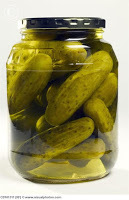 We put pickle number one in the oven and cranked up the heat: 350 degrees, 400, 450, 500, and then finally 550 degrees, as hot as an oven could go. The pickle turned black. He began to smoke. When we finally rescued him, he weighed absolutely nothing, as all the water had evaporated out of him. He was a mere hollow pickle skeleton.
We put pickle number one in the oven and cranked up the heat: 350 degrees, 400, 450, 500, and then finally 550 degrees, as hot as an oven could go. The pickle turned black. He began to smoke. When we finally rescued him, he weighed absolutely nothing, as all the water had evaporated out of him. He was a mere hollow pickle skeleton.
We put pickle number two in a pot of water and boiled him for an hour. He came out fresh as a daisy, not at all minding a pleasant soak in the pickle hot tub.
Then we put pickle number three in the microwave and set the timer for twenty minutes, during which time the pickle turned gray and pimply, lost all his moisture to evaporation. . . and shorted out the microwave, which ended up requiring a $200 repair.
But now I had my pickle details for the book! AND the favorite story, by far, of all I share during school assemblies. In fact, it was a kid in one assembly who gave me the line about the pickle hot tub, which has become the biggest laugh line in the program.
Here are the three pickles in all their glory.
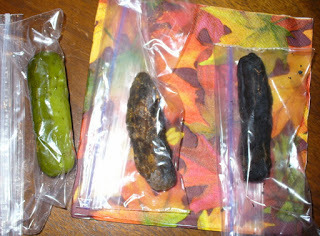 So hooray for field trips - not only because they improve our writing, but because they can enrich our school visits, too.
So hooray for field trips - not only because they improve our writing, but because they can enrich our school visits, too.
It was the time my writer friend Leslie and I spent an afternoon together trying to explode a pickle.
As I was writing Fractions = Trouble! I knew the book would have a science-fair subplot.
 I adore science fairs, and to date I have at least three published books where I managed to work one into the story. So off I trotted to my sons' former elementary school on the day of the science fair, notebook in hand, to record the funniest, weirdest, craziest science projects on display. I gave a squeal of joy at this one, where a fifth-grade boy set out to answer the question: "At what temperature does a pickle explode?"
I adore science fairs, and to date I have at least three published books where I managed to work one into the story. So off I trotted to my sons' former elementary school on the day of the science fair, notebook in hand, to record the funniest, weirdest, craziest science projects on display. I gave a squeal of joy at this one, where a fifth-grade boy set out to answer the question: "At what temperature does a pickle explode?"I drafted the chapter where Wilson and his best friend Josh try- and fail - to explode the pickle and then shared it with my writing group. They loved the premise, but not the execution. They wanted more details involving the pickle: what did it look like? smell like? sound like? Alas, I had to confess I had no further details to offer, because I myself had never tried to explode a pickle. "Oh," they said. "You need to do that."
But. . . but . . .
"Come over to my house," Leslie offered. "We'll explode it there."
I bought a big jar of pickles and presented myself at Leslie's door.
 We put pickle number one in the oven and cranked up the heat: 350 degrees, 400, 450, 500, and then finally 550 degrees, as hot as an oven could go. The pickle turned black. He began to smoke. When we finally rescued him, he weighed absolutely nothing, as all the water had evaporated out of him. He was a mere hollow pickle skeleton.
We put pickle number one in the oven and cranked up the heat: 350 degrees, 400, 450, 500, and then finally 550 degrees, as hot as an oven could go. The pickle turned black. He began to smoke. When we finally rescued him, he weighed absolutely nothing, as all the water had evaporated out of him. He was a mere hollow pickle skeleton.We put pickle number two in a pot of water and boiled him for an hour. He came out fresh as a daisy, not at all minding a pleasant soak in the pickle hot tub.
Then we put pickle number three in the microwave and set the timer for twenty minutes, during which time the pickle turned gray and pimply, lost all his moisture to evaporation. . . and shorted out the microwave, which ended up requiring a $200 repair.
But now I had my pickle details for the book! AND the favorite story, by far, of all I share during school assemblies. In fact, it was a kid in one assembly who gave me the line about the pickle hot tub, which has become the biggest laugh line in the program.
Here are the three pickles in all their glory.
 So hooray for field trips - not only because they improve our writing, but because they can enrich our school visits, too.
So hooray for field trips - not only because they improve our writing, but because they can enrich our school visits, too.
Published on September 18, 2018 02:53
September 15, 2018
This Magnificent Madness!
“One tiny Hobbit against all the evil the world could muster. A sane being would have given up, but Samwise burned with a magnificent madness, a glowing obsession to surmount every obstacle, to find Frodo, destroy the Ring, and cleanse Middle Earth of its festering malignancy. He knew he would try again. Fail, perhaps. And try once more. A thousand, thousand times if need be, but he would not give up the quest.” -- J.R.R. Tolkien The Return of the King
Last time I wrote about my ongoing search for a new agent. Until my stories find this champion, I continue to study in hopes of mastering my craft. In my ongoing quest, I returned to an old favorite, a steady, inspirational read by Christopher Vogler, The Writer’s Journey (Michael Wiese Productions, 1992)
While the book explores the monomyth, made famous by Joseph Campbell, and its impact in the storytelling process, Vogler expands the myth to include the writer herself. Every storyteller bends this archetypal pattern to her own purpose or the needs of her culture. That’s why the hero has a thousand faces, states Vogler. But at the heart of the story is always a journey.
"It's a dangerous business, Frodo, going out your door. You step onto the road, and if you don't keep your feet, there's no knowing where you might be swept off to.” -- J.R.R. Tolkien, The Lord of the Rings
The hero’s journey, you may remember, is found in all sorts of storytelling, most especially in adolescent and young adult. The profound truth of adolescence is the separation from parent, the search for uniqueness and the triumphant integrating into wholeness – the return to being. You can see how this hero’s journey is mapped out in J. K. Rowling’s Harry Potter and the Sorcerer’s Stone, Lois Lowry’s The Giver, and Rick Riordan’s The Lightning Thief.
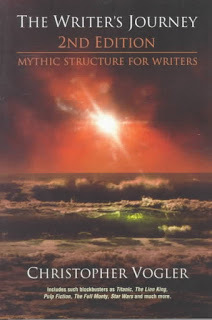
Writers go on a similar journey, states Vogler. In fact, as he states, “The hero’s journey and the writer’s journey are one and the same.”
Most writers I know received their call to adventure at a young age. George Orwell knew he wanted to be a writer by the time he was five. Neil Gaiman also discovered his love of story at a young age, describing himself as “a feral child who was raised in libraries.” J.K. Rowling wrote her first story at age six, a book about a rabbit with measles. Raised by her grandparents, Lucy Maud Montgomery battled a debilitating sense of loneliness by creating imaginary friends, Katie Maurice and Lucy Gray, who lived in a fairy room behind a bookcase.
“The world is indeed full of peril, and in it there are many dark places; but still there is much that is fair, and though in all lands love is now mingled with grief, it grows perhaps the greater.” -- J.R.R. Tolkien, The Fellowship of the Ring
Writing is certainly hard work, “a perilous journey inward to probe the depths of one soul.” It is a fearsome process, no matter how many books one has under their belts. Sue Grafton, author of the wildly popular Kinsey Millhone Alphabet Series, once stated, “Most days when I sit down at my computer, I’m scared half out of my mind.” The mighty Stephen King noted, “I’m afraid of failing at whatever story I’m writing – that it won’t come up for me, or I won’t be able to finish it.” Even the mythic J.R.R. Tolkien said, as the first book of his iconic series was published, “It is written in my life-blood…I am dreading the publication, for it will be impossible not to mind what is said. I have exposed my heart to be shot at.”
So why write, we ask ourselves? We go through all this agony!
Says Mary Karr (The Liar’s Club), “I write to dream; to connect with other human beings; to record; to clarify; to visit the dead. I have a kind of primitive need to leave a mark on the world.”
Vogler shows that anyone – new as well as established writers – who sets out to write a story encounters all the trials and tribulations, joys and rewards of the hero’s journey.
A writer encounters her trickster, taking shape as computer problems, doctor appointments and time management issues, and other “enemies of the status quo that also bring perspective on the process.
A writer meets the grumpy threshold guardian in the form of our inner and relentless judgments of our work. The tension rises as we face the searing remarks of a reviewer, a copyeditor, an agent, or an editor. And finally, we cross the Rubicon. We are published. But the journey is just beginning, as we “fully enter the mysterious, exciting Special World” of a published writer. The ordeals become all the more exhausting as we face deadlines and revisions and constant rejections. As we build our platforms and speak – holy moly! – to readers. And our beloveds go out of print, and favorite editors retire, and the rise of the internet dragons.
Along the way, if we are lucky, we meet our sidekicks, our Dr. Watson, our Clara Oswald, our Hermione Granger. Our Samwise Gamgee. Sometimes, we meet our Dumbledore or Gandolf wielding his magic purple crayon, the sage who gives advice, who tells us to keep going, just keep swimming. Don’t give up.
Take hope, states Vogler, “for writing is magic. Even the simplest act of writing is almost supernatural…We can make a few abstract marks on a piece of paper in a certain order and someone a world away and a thousand years from now can know our deepest thoughts. The boundaries of space and time and even the limitations of death can be transcended.”
“It's like in the great stories, Mr. Frodo. The ones that really mattered. Full of darkness and danger they were. And sometimes you didn't want to know the end… because how could the end be happy? How could the world go back to the way it was when so much bad had happened? But in the end, it’s only a passing thing… this shadow. Even darkness must pass.” -- J.R.R. Tolkien, The Two Towers
Happy journeys to you!
--Bobbi Miller
Published on September 15, 2018 03:29
September 14, 2018
Listening for great snippets of dialogue, by Michele Weber Hurwitz
Our blog topic this month is about field trips; more specifically, where we like to write. But here's the deal: I write and revise at home. Routine and familiarity suit me and my work. I've found, through trial and error, that coffee shops are too loud and distracting, and have the inherent risk of hot beverage spills and muffin bits that get stuck in those temperamental laptop keys. Anywhere outdoors is always fraught with assorted dogs/bugs/humidity/sudden thunderstorms that crop up out of nowhere. Airports, hotel rooms, the lakeside cabin porch where I thought I would be able to concentrate - nope, not happening.
My cozy home office overlooking my backyard and filled with photos and inspiring sayings, my giant screen desktop computer, and space to spread out my piles of notes - now we're talking. And even better, it's exactly twenty-three steps to the kitchen pantry.
But! When it comes to dialogue, I emerge from my cocoon, go somewhere, and listen. Great snippets of dialogue can be overhead anywhere and everywhere, be it a restaurant, store, sporting event, or family get-together (those are usually a gold mine). More than one overheard gem has found its way into one of my books!
 Here are some of the recent snippets I've overheard:
Here are some of the recent snippets I've overheard:
"No, not that. I told you. We're not looking for a bathtub."
"I sprinkled Wheat Thin crumbs on his car."
"This thing ran outta juice. They didn't charge it enough."
"Oh, you knew! You most certainly knew!"
"Did you feel safe there? I mean, like, here safe."
"Don't go anywhere, I'm getting the pineapple."
"They said to get zip-off pants. You know, the kind that zip off."
"She's not totally mean. She's just, like, partially totally mean."
I first learned of this simple but effective dialogue exercise while taking a summer course at the University of Iowa's Writer's Workshop years (and years) ago. The instructor asked us to sit for one hour in the open-air Ped Mall and jot down bits of conversation we heard from people passing by. Afterwards, we returned to class and wrote a scene with these bits of conversation. The results were hilarious and in some cases, made no sense, but all of the resulting scenes reflected how people really speak to each other. It was a lesson I never forgot.
Michele Weber Hurwitz is the author of four middle grade novels, from Penguin Random House and Simon & Schuster. Her newest, Ethan Marcus Makes His Mark, publishes on November 13. Visit her at micheleweberhurwitz.com.
My cozy home office overlooking my backyard and filled with photos and inspiring sayings, my giant screen desktop computer, and space to spread out my piles of notes - now we're talking. And even better, it's exactly twenty-three steps to the kitchen pantry.
But! When it comes to dialogue, I emerge from my cocoon, go somewhere, and listen. Great snippets of dialogue can be overhead anywhere and everywhere, be it a restaurant, store, sporting event, or family get-together (those are usually a gold mine). More than one overheard gem has found its way into one of my books!
 Here are some of the recent snippets I've overheard:
Here are some of the recent snippets I've overheard:"No, not that. I told you. We're not looking for a bathtub."
"I sprinkled Wheat Thin crumbs on his car."
"This thing ran outta juice. They didn't charge it enough."
"Oh, you knew! You most certainly knew!"
"Did you feel safe there? I mean, like, here safe."
"Don't go anywhere, I'm getting the pineapple."
"They said to get zip-off pants. You know, the kind that zip off."
"She's not totally mean. She's just, like, partially totally mean."
I first learned of this simple but effective dialogue exercise while taking a summer course at the University of Iowa's Writer's Workshop years (and years) ago. The instructor asked us to sit for one hour in the open-air Ped Mall and jot down bits of conversation we heard from people passing by. Afterwards, we returned to class and wrote a scene with these bits of conversation. The results were hilarious and in some cases, made no sense, but all of the resulting scenes reflected how people really speak to each other. It was a lesson I never forgot.
Michele Weber Hurwitz is the author of four middle grade novels, from Penguin Random House and Simon & Schuster. Her newest, Ethan Marcus Makes His Mark, publishes on November 13. Visit her at micheleweberhurwitz.com.
Published on September 14, 2018 05:00
September 12, 2018
Writer's Field Trips by Darlene Beck Jacobson
Another School year begins and it never fails to send me back to my own school days. In keeping with our September theme of field trips and places we go to write, I want to share some of the things I learned about writing and life from the field trips I took in elementary school.
We grew up in a small working class town along the Raritan Bay in NJ. No one was wealthy, many of us - my family included - would be considered poor by today's standards. But as I look back, I realize how much the schools did to try and level the field by providing enriching experiences via class trips. Located within an hour's drive of NY City, we took advantage of the opportunities. In third grade we took a ferry boat to the Staten Island Zoo, passing by the Statue of Liberty on the way. First lesson: It's a big world out there and sometimes you need a boat to get to a special place.
In fourth grade we visited George Washington's Headquarters in Morristown, NJ, and though I don't remember much of the trip, one fact stayed with me. To get the pretty rose color on the walls of the interior, brick was crushed and pulverized into the paint. That someone would go to so much trouble to make something look beautiful amazed me. Lesson: History is much more than dates and battles. It's people at their best and worst. This began my love of history.
In sixth grade we had the opportunity of a lifetime when we took our class trip to the New York World's Fair in 1964. Held in Flushing Meadows, Queens, the theme was "Peace Through Understanding". An international gathering on four square miles of land. Lesson: The world has so much to offer. Think beyond your own small part of it and appreciate what other cultures have given to mankind. This is a lesson some of us still need to work on.
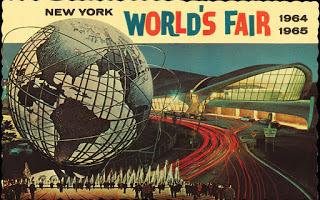
I have no doubt that these lessons formed the foundation of my writing. These beginnings - along with my adult trips as a teacher and mother - influence what I write and continually give me inspiration for the young characters I create. Tapping into these "field trips" is research of the best kind.
We grew up in a small working class town along the Raritan Bay in NJ. No one was wealthy, many of us - my family included - would be considered poor by today's standards. But as I look back, I realize how much the schools did to try and level the field by providing enriching experiences via class trips. Located within an hour's drive of NY City, we took advantage of the opportunities. In third grade we took a ferry boat to the Staten Island Zoo, passing by the Statue of Liberty on the way. First lesson: It's a big world out there and sometimes you need a boat to get to a special place.
In fourth grade we visited George Washington's Headquarters in Morristown, NJ, and though I don't remember much of the trip, one fact stayed with me. To get the pretty rose color on the walls of the interior, brick was crushed and pulverized into the paint. That someone would go to so much trouble to make something look beautiful amazed me. Lesson: History is much more than dates and battles. It's people at their best and worst. This began my love of history.
In sixth grade we had the opportunity of a lifetime when we took our class trip to the New York World's Fair in 1964. Held in Flushing Meadows, Queens, the theme was "Peace Through Understanding". An international gathering on four square miles of land. Lesson: The world has so much to offer. Think beyond your own small part of it and appreciate what other cultures have given to mankind. This is a lesson some of us still need to work on.

I have no doubt that these lessons formed the foundation of my writing. These beginnings - along with my adult trips as a teacher and mother - influence what I write and continually give me inspiration for the young characters I create. Tapping into these "field trips" is research of the best kind.
Published on September 12, 2018 06:00
September 11, 2018
Where?
from Jody FeldmanThis month, I've opted to answer this question: Where do you work?
Let me show you instead.
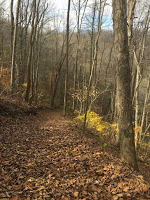 I work here
I work here
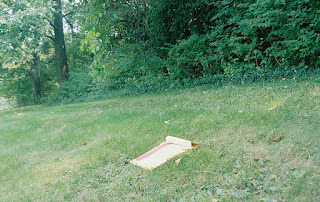 I work here.
I work here.
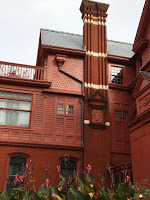 I work here.
I work here.
 I work here.
I work here.
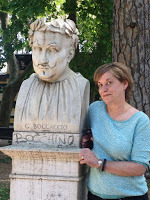 I work here.
I work here.
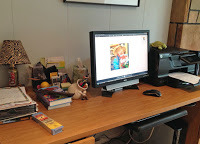 But I type here.
But I type here.
 The better question is: Where DON"T I write?
The better question is: Where DON"T I write?
Let me show you instead.
 I work here
I work here I work here.
I work here. I work here.
I work here. I work here.
I work here. I work here.
I work here. But I type here.
But I type here.
 The better question is: Where DON"T I write?
The better question is: Where DON"T I write?
Published on September 11, 2018 04:00
September 8, 2018
Incantations -- by Jane Kelley
Writing a novel can be like an archeological dig. You pick a likely place to search for artifacts and other treasures with stories. If you don't find anything interesting enough, move your shovel.
It helps to be curious. And it helps not to know exactly what you're looking for.
Midway through draft three of a novel (with the working title of "Mau" after the feral black cat who linked the main characters), I went to visit my daughter at the University of Chicago. While she studied at the library, I wandered into the Oriental Institute--a museum for objects taken from the Near East.
I was searching for examples of early writing. (I love thinking about what inspired that great leap from reality to symbols.) The Institute does have some lovely cuneiform clay tablets. But in another glass case, I discovered precisely what I had been looking for––even though I didn't know what it was or even that such things existed.
An Incantation Bowl.
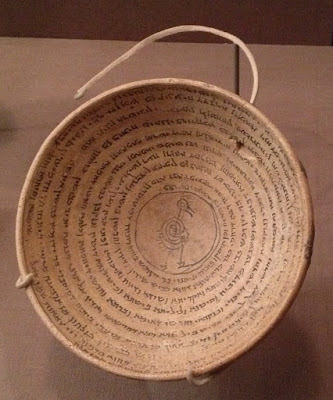
These terra-cotta bowls were found buried upside-down near houses to trap any evil spirits lurking nearby. The bowls were often particular protections to a certain member of the family, presumably whoever was most at risk. In the center of this bowl, you can see a depiction of the demon, who has been tied down.
Writing spirals from the bowl's outer edge to where the demon is bound. This is the incantation, the invocation, the charm, the hex. This one is in Aramaic and ends with these phrases: May god rebuke you, Satan. . . Is this not a brand snatched from the fire?

In the modern era, we have better explanations for madness or risky behavior than demons. So what could this artifact possibly have to do with my story about a girl Lanora whose desire to reinvent herself endangers her?
Her loyal friend Val doesn't really think Lanora is under a spell. And yet Lanora is acting so unlike herself that Val is worried. The cat Mau leads Val to Tasman who lives in an antiquities store. Tasman offers to help save Lanora with a book of spells. Val quizzes Tasman whether he really believes ancient spells have power. Tasman's answer is: "I believe in the power of believing."
I do too. That incantation bowl certainly helped me cast a powerful spell in my novel, which was eventually titled, The Book of Dares For Lost Friends. (Although the title I preferred was "Incantation For a Lost Friend.")
"What gives the material its otherworldly power is the way these three very different children (and a quartet of classmates that almost acts like a chorus) use ritual and magical thinking to find the faith they need to persevere and mature." -- said Kirkus in a starred review.
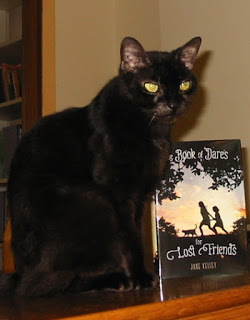
One final thought -- I need to give credit to Blackberry who inspired Mau.
It helps to be curious. And it helps not to know exactly what you're looking for.
Midway through draft three of a novel (with the working title of "Mau" after the feral black cat who linked the main characters), I went to visit my daughter at the University of Chicago. While she studied at the library, I wandered into the Oriental Institute--a museum for objects taken from the Near East.
I was searching for examples of early writing. (I love thinking about what inspired that great leap from reality to symbols.) The Institute does have some lovely cuneiform clay tablets. But in another glass case, I discovered precisely what I had been looking for––even though I didn't know what it was or even that such things existed.
An Incantation Bowl.

These terra-cotta bowls were found buried upside-down near houses to trap any evil spirits lurking nearby. The bowls were often particular protections to a certain member of the family, presumably whoever was most at risk. In the center of this bowl, you can see a depiction of the demon, who has been tied down.
Writing spirals from the bowl's outer edge to where the demon is bound. This is the incantation, the invocation, the charm, the hex. This one is in Aramaic and ends with these phrases: May god rebuke you, Satan. . . Is this not a brand snatched from the fire?

In the modern era, we have better explanations for madness or risky behavior than demons. So what could this artifact possibly have to do with my story about a girl Lanora whose desire to reinvent herself endangers her?
Her loyal friend Val doesn't really think Lanora is under a spell. And yet Lanora is acting so unlike herself that Val is worried. The cat Mau leads Val to Tasman who lives in an antiquities store. Tasman offers to help save Lanora with a book of spells. Val quizzes Tasman whether he really believes ancient spells have power. Tasman's answer is: "I believe in the power of believing."
I do too. That incantation bowl certainly helped me cast a powerful spell in my novel, which was eventually titled, The Book of Dares For Lost Friends. (Although the title I preferred was "Incantation For a Lost Friend.")
"What gives the material its otherworldly power is the way these three very different children (and a quartet of classmates that almost acts like a chorus) use ritual and magical thinking to find the faith they need to persevere and mature." -- said Kirkus in a starred review.

One final thought -- I need to give credit to Blackberry who inspired Mau.
Published on September 08, 2018 03:00



